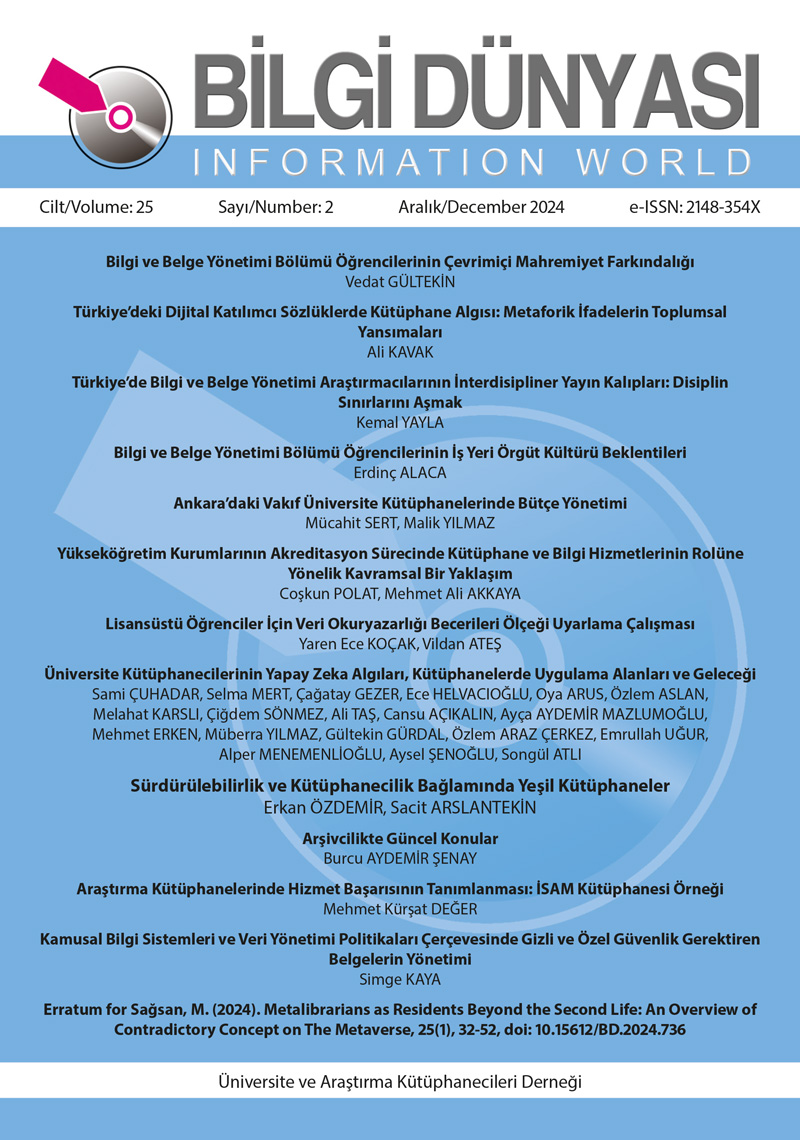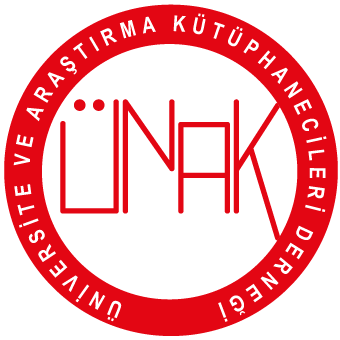The Interdisciplinary Publication Patterns of Information and Document Management Researchers in Turkey: Crossing Disciplinary Boundaries
DOI:
https://doi.org/10.15612/BD.2024.757Keywords:
Library and Information Science, interdisciplinary research, Radius of Gyration, UMAP, Word2vec, publication patternAbstract
Bu çalışmada, Türkiye’deki Bilgi ve Belge Yönetimi (BBY) araştırmacılarının interdisipliner yayın örüntüleri incelenerek, akademik yayın eğilimlerinin alandaki küresel eğilimlerle uyumlu olup olmadığı belirlenmeye çalışılmıştır. Veri odaklı ve tekrarlanabilir bir araştırma metodolojisi benimsenmiştir. Türkiye’deki 13 aktif üniversiteden 100 BBY araştırmacısının dergi makaleleri YÖK Akademik veri tabanından derlenmiştir. Ayrıca yayınlar, TR Dizin veri tabanından elde edilen ilgili dergiler kullanılarak analiz edilmiştir. Anlamsal ilişkileri belirlemek için Word2Vec, görselleştirme için UMAP ve araştırmacıların interdisipliner eğilimlerini niceliksel olarak ifade etmek için Dönme Yarıçapı (ROG) hesaplanmıştır. Demografik değişkenlere dayalı farklılıkları değerlendirmek için t-testleri ve ANOVA uygulanmıştır. Bulgular, Türkiye’deki BBY araştırmacılarının ortalama ROG değerinin 7,23 olduğunu ve interdisipliner sınırları aşma yönünde genel bir eğilim olduğunu ortaya koymaktadır. Akademik unvan, cinsiyet veya kuruma dayalı olarak interdisipliner eğilimlerde anlamlı bir fark bulunamamıştır. Çalışma, BBY alanının disiplinler arası doğasının anlaşılmasını derinleştirerek, gelişmiş veri analizi yöntemleri aracılığıyla metodolojik yenilikler sunar ve benzersiz bir veri seti oluşturarak literatüre katkıda bulunmaktadır. Gelecekteki araştırmalar, daha kapsamlı veri setleri kullanarak ve uluslararası karşılaştırmalı analizler yürüterek BBY alanındaki interdisipliner eğilimleri araştırılması önerilmektedir.
Downloads
References
Adam Holland, G. (2008). Information science: An interdisciplinary effort? Journal of Documentation, 64(1), 7-23. https://doi.org/10.1108/00220410810844132
Adams, J., ve Szomszor, M. (2022). A converging global research system. Quantitative Science Studies, 3(3), 715-731. https://doi.org/10.1162/qss_a_00208
Arafat, S., Buckland, M., Feinberg, M., Ibekwe‐SanJuan, F., Shaw, R., ve Warner, J. (2014). Pluri, multi‐, trans‐ meta‐ and interdisciplinary nature of LIS. Does it really matter? Proceedings of the American Society for Information Science and Technology, 51(1), 1-5. https://doi.org/10.1002/meet.2014.14505101010
Aram, J. D. (2004). Concepts of interdisciplinarity: Configurations of knowledge and action. Human Relations, 57(4), 379-412. https://doi.org/10.1177/0018726704043893
Arslantekin, S. (2024). Disiplinlerarası bakış ile bilgi ve belge yönetimi. İçinde P. Bezirci ve I. Sert (Ed.), Cumhuriyet’in 100. Yılında Bilgi ve Belge Yönetimi Teknolojisinde Güncel Yaklaşımlar (ss. 833-851). Istanbul University Press. https://doi.org/10.26650/B/ SS53.2024.015.32
Austin, T. R., Rauch, A., Blau, H., Yudice, G., Van Den Berg, S., Robinson, L. S., Henkel, J., Murray, T., Schoenfield, M., Traub, V., ve De Marco Torgovnick, M. (1996). Defining Interdisciplinarity. Publications of the Modern Language Association of America, 111(2), 271-282. https://doi.org/10.2307/463106
Bates, M. J. (1999). The invisible substrate of information science. Journal of the American Society for Information Science, 50(12), 1043-1050. https://doi.org/10.1002/(SICI)10974571(1999)50:12<1043::AID-ASI1>3.0.CO;2-X
Bates, M. J. (2007). Defining the information disciplines in encyclopedia development. Information Research, 12(4). https://informationr.net/ir/12-4/colis/colis29.html
Bawden, D. (2007). Organised complexity, meaning and understanding: An approach to a unified view of information for information science. Aslib Proceedings, 59(4/5), 307-327. https://doi.org/10.1108/00012530710817546
Blei, D. M., Ng, A. Y., ve Jordan, M. I. (2003). Latent dirichlet allocation. The Journal of Machine Learning Research, 3, 993-1022.
Bonaccorsi, A., Melluso, N., ve Massucci, F. A. (2022). Exploring the antecedents of interdisciplinarity at the European Research Council: A topic modeling approach. Scientometrics, 127(12), 6961-6991. https://doi.org/10.1007/s11192-022-04368-9
Bonnici, L. J., Subramaniam, M. M., ve Burnett, K. (2009). Everything old is new again: The evolution of library and information science education from LIS to iField. Journal of Education for Library and Information Science, 263-274.
Buckland, M. (2012). What kind of science can information science be? Journal of the American Society for Information Science and Technology, 63(1), 1-7. https://doi.org/10.1002/asi.21656
Burnett, K., ve Bonnici, L. J. (2013). Rhizomes in the iField: What does it mean to be an iSchool? KO Knowledge Organization, 40(6), 408-413. https://doi.org/10.5771/09437444-2013-6-408
Carayol, N., ve Thi, T. U. N. (2005). Why do academic scientists engage in interdisciplinary research? Research Evaluation, 14(1), 70-79. https://doi.org/10.3152/147154405781776355
Chang, Y., ve Huang, M. (2012). A study of the evolution of interdisciplinarity in library and information science: Using three bibliometric methods. Journal of the American Society for Information Science and Technology, 63(1), 22-33. https://doi.org/10.1002/ asi.21649
Chang, Y.-W. (2018). Exploring the interdisciplinary characteristics of library and information science (LIS) from the perspective of interdisciplinary LIS authors. Library & Information Science Research, 40(2), 125-134. https://doi.org/10.1016/j. lisr.2018.06.004
Cronin, B. (2012). The waxing and waning of a field: Reflections on information studies education. Information Research: An International Electronic Journal, 17(3), n3.
Darbellay, F. (2015). Rethinking inter- and transdisciplinarity: Undisciplined knowledge and the emergence of a new thought style. Futures, 65, 163-174. https://doi.org/10.1016/j.futures.2014.10.009
Evans, E. D. (2016). Measuring Interdisciplinarity Using Text. Socius: Sociological Research for a Dynamic World, 2, 237802311665414. https://doi.org/10.1177/2378023116654147
Frodeman, R. (2011). Interdisciplinary research and academic sustainability: Managing knowledge in an age of accountability. Environmental Conservation, 38(2), 105-112. https://doi.org/10.1017/S0376892911000038
Frodeman, R., ve Mitcham, C. (2007). New directions in interdisciplinarity: Broad, deep, and critical. Bulletin of Science, Technology & Society, 27(6), 506-514. https://doi.org/10.1177/0270467607308284
Glänzel, W., ve Debackere, K. (2022). Various aspects of interdisciplinarity in research and how to quantify and measure those. Scientometrics, 127(9), 5551-5569. https://doi.org/10.1007/s11192-021-04133-4
González, M. C., Hidalgo, C. A., ve Barabási, A.-L. (2008). Understanding individual human mobility patterns. Nature, 453(7196), 779-782. https://doi.org/10.1038/nature06958
Gowanlock, M., ve Gazan, R. (2013). Assessing researcher interdisciplinarity: A case study of the University of Hawaii NASA Astrobiology Institute. Scientometrics, 94(1), 133-161. https://doi.org/10.1007/s11192-012-0765-y
Hjørland, B. (2014). Information science and its core concepts: Levels of disagreement. Içinde F. Ibekwe-SanJuan ve T. M. Dousa (Ed.), Theories of Information, Communication and Knowledge (C. 34, ss. 205-235). Springer Netherlands. https://doi.org/10.1007/97894-007-6973-1_9
Huutoniemi, K., Klein, J. T., Bruun, H., ve Hukkinen, J. (2010). Analyzing interdisciplinarity: Typology and indicators. Research Policy, 39(1), 79-88. https://doi.org/10.1016/j. respol.2009.09.011
Karakaş, H. S. (2014). Disiplinlerarası yaklaşımlar ve bilgi ve belge yönetimindeki yansımaları. İçinde N. Özel ve N. Er-Koçoğlu (Ed.), Ankara Üniversitesi Bilgi ve Belge Yönetimi Bölümü 60.yıl armağan kitabı (ss. 65-80). Ankara Üniversitesi Yayınları.
Kayaoğlu, H. D. (2019). Türkiye’de Kütüphane ve Bilgibilimi Araştırmalarında Kuram Kullanımı: Bir İçerik Analizi. Türk Kütüphaneciliği, 33(4), 249-266.
Keseroğlu, H. S. (2010). Bilginin bilgisi: Kütüphane ve bilgibilim kuramı sorunsalı. Türk Kütüphaneciliği, 24(4), 685-704.
Koch, T., ve Vanderstraeten, R. (2021). Journal editors and journal indexes: Internationalization pressures in the semi‐periphery of the world of science. Learned Publishing, 34(4), 519-527. https://doi.org/10.1002/leap.1390
Kumar, S., Zöphel, C., Martius, A., Cabadag, R., Plewnia, F., Pruditsch, N., Sakowski, B. A., ve Möst, D. (2019). Stronger together—A framework for measuring interdisciplinary understanding. WIREs Energy and Environment, 8(6), e348. https://doi.org/10.1002/ wene.348
Larivière, V., ve Gingras, Y. (2010). On the relationship between interdisciplinarity and scientific impact. Journal of the American Society for Information Science and Technology, 61(1), 126-131. https://doi.org/10.1002/asi.21226
Lau, L., ve Pasquini, M. W. (2004). Meeting grounds: Perceiving and defining interdisciplinarity across the arts, social sciences and sciences. Interdisciplinary Science Reviews, 29(1), 49-64. https://doi.org/10.1179/030801804225012437
Lopatovska, I., ve Ransom, E. (2016). The state of L-Schools: Intellectual diversity and faculty composition. Journal of Librarianship and Information Science, 48(1), 18-35. https://doi.org/10.1177/0961000614533718
Mansilla Boix, V. (2006). Assessing expert interdisciplinary work at the frontier: An empirical exploration. Research Evaluation, 15(1), 17-29. https://doi.org/10.3152/147154406781776075
McInnes, L., Healy, J., Saul, N., ve Großberger, L. (2018). UMAP: Uniform Manifold Approximation and Projection. Journal of Open Source Software, 3(29), 861. https://doi.org/10.21105/joss.00861
Mikolov, T., Chen, K., Corrado, G., ve Dean, J. (2013). Efficient estimation of word representations in vector space. arXiv preprint arXiv:1301.3781.
Morillo, F., Bordons, M., ve Gómez, I. (2003). Interdisciplinarity in science: A tentative typology of disciplines and research areas. Journal of the American Society for Information Science and Technology, 54(13), 1237-1249. https://doi.org/10.1002/ asi.10326
Mugabushaka, A.-M., Kyriakou, A., ve Papazoglou, T. (2016). Bibliometric indicators of interdisciplinarity: The potential of the Leinster–Cobbold diversity indices to study disciplinary diversity. Scientometrics, 107(2), 593-607. https://doi.org/10.1007/s11192016-1865-x
Okamura, K. (2019). Interdisciplinarity revisited: Evidence for research impact and dynamism. Palgrave Communications, 5(1), 141. https://doi.org/10.1057/s41599-019 0352-4
Özdemirci, F. (2017). Belge ve arşiv yönetiminde yeni ufuklar ve kuramsal yaklaşımlar. İçinde B. Yılmaz, M. Dişli, S. Öztemiz, ve T. Baş (Ed.), Bilgi ve Belge Yönetimi: Kuramsal yaklaşımlar. Hiperlink.
Pham, H.-S., Vancraeynest, B., Poelmans, H., Vancauwenbergh, S., ve Ali-Eldin, A. (2023). Identifying interdisciplinary research in research projects. Scientometrics, 128(10), 5521-5544. https://doi.org/10.1007/s11192-023-04810-6
Pilkington, A., ve Liston‐Heyes, C. (1999). Is production and operations management a discipline? A citation/co‐citation study. International Journal of Operations & Production Management, 19(1), 7-20. https://doi.org/10.1108/01443579910244188
Porter, A. L., Cohen, A. S., David Roessner, J., ve Perreault, M. (2007). Measuring researcher interdisciplinarity. Scientometrics, 72(1), 117-147. https://doi.org/10.1007/s11192-0071700-5
Porter, A. L., ve Rafols, I. (2009). Is science becoming more interdisciplinary? Measuring and mapping six research fields over time. Scientometrics, 81(3), 719-745. https://doi.org/10.1007/s11192-008-2197-2
Prebor, G. (2010). Analysis of the interdisciplinary nature of library and information science. Journal of Librarianship and Information Science, 42(4), 256-267. https://doi.org/10.1177/0961000610380820
Raimbault, J. (2019). Exploration of an interdisciplinary scientific landscape. Scientometrics, 119(2), 617-641. https://doi.org/10.1007/s11192-019-03090-3
Rhoten, D., ve Pfirman, S. (2007). Women in interdisciplinary science: Exploring preferences and consequences. Research Policy, 36(1), 56-75. https://doi.org/10.1016/j.respol.2006.08.001
Saracevic, T. (1999). Information science. Journal of the American Society for Information Science, 50(12), 1051-1063. https://doi.org/10.1002/(SICI)1097-4571(1999)50:12<1051::AIDASI2>3.0.CO;2-Z
Sayama, H., ve Akaishi, J. (2012). Characterizing interdisciplinarity of researchers and research topics using web search engines. PLoS ONE, 7(6), e38747. https://doi.org/10.1371/journal.pone.0038747
Shu, F., Larivière, V., Mongeon, P., Julien, C.-A., ve Piper, A. (2016). On the evolution of library and information science doctoral dissertation topics in North America (1960–2013). Journal of Education for Library and Information Science, 57(2), 131-142. https://doi.org/10.3138/jelis.57.2.131
Shu, F., ve Mongeon, P. (2016). The evolution of iSchool movement (1988-2013): A bibliometric view. Education for Information, 32(4), 359-373. https://doi.org/10.3233/ EFI-160982
Slonim, N., Friedman, N., ve Tishby, N. (2002). Unsupervised document classification using sequential information maximization. Proceedings of the 25th Annual International ACM SIGIR Conference on Research and Development in Information Retrieval, 129-136. https://doi.org/10.1145/564376.564401
Song, C., Koren, T., Wang, P., ve Barabási, A.-L. (2010). Modelling the scaling properties of human mobility. Nature Physics, 6(10), 818-823. https://doi.org/10.1038/nphys1760
Sugimoto, C. R. (2009). Proposal and application of the interdisciplinarity borrowing index: Determining the degrees of interdisciplinarity of ILS dissertations. Proceedings of the American Society for Information Science and Technology, 46(1), 1-6. https://doi.org/10.1002/meet.2009.1450460392
Sugimoto, C. R., Ni, C., Russell, T. G., ve Bychowski, B. (2011). Academic genealogy as an indicator of interdisciplinarity: An examination of dissertation networks in Library and Information Science. Journal of the American Society for Information Science and Technology, 62(9), 1808-1828. https://doi.org/10.1002/asi.21568
Tonta, Y. (2012). Kütüphanecilik ve bilgibilim eğitiminde gelişmeler ve program değişiklikleri. Türk Kütüphaneciliği, 26(2), 227-261. http://www.tk.org.tr/index.php/ TK/article/view/314
Torunlar, M. (2020). Belge/Bilgi Yönetimi disiplininde olası paradigma değişiklikleri: Yeni Bir rota teklifi. Bilgi Yönetimi, 3(2), 143-156. https://doi.org/10.33721/by.777442
Vakkari, P. (2024). What characterizes LIS as a fragmenting discipline? Journal of Documentation, 80(7), 60-77. https://doi.org/10.1108/JD-10-2023-0207
Van Noorden, R. (2015). Interdisciplinary research by the numbers. Nature, 525(7569), 306-307. https://doi.org/10.1038/525306a
Vienni-Baptista, B., Fletcher, I., Lyall, C., ve Pohl, C. (2022). Embracing heterogeneity: Why plural understandings strengthen interdisciplinarity and transdisciplinarity. Science and Public Policy, 49(6), 865-877. https://doi.org/10.1093/scipol/scac034
Wang, X., Wang, Z., Huang, Y., Chen, Y., Zhang, Y., Ren, H., Li, R., ve Pang, J. (2017). Measuring interdisciplinarity of a research system: Detecting distinction between publication categories and citation categories. Scientometrics, 111(3), 2023-2039. https://doi.org/10.1007/s11192-017-2348-4
Wiggins, A., ve Sawyer, S. (2012). Intellectual diversity and the faculty composition of iSchools. Journal of the American Society for Information Science and Technology, 63(1), 8-21. https://doi.org/10.1002/asi.21619
Wu, D., He, D., Jiang, J., Dong, W., ve Vo, K. T. (2012). The state of iSchools: An analysis of academic research and graduate education. Journal of Information Science, 38(1), 1536. https://doi.org/10.1177/0165551511426247
Yegros-Yegros, A., Rafols, I., ve D’Este, P. (2015). Does interdisciplinary research lead to higher citation impact? The different effect of proximal and distal interdisciplinarity. PLoS ONE, 10(8), e0135095. https://doi.org/10.1371/journal.pone.0135095
Zhuge, H. (2006). Discovery of knowledge flow in science. Communications of the ACM, 49(5), 101-107. https://doi.org/10.1145/1125944.1125948
Published
How to Cite
Issue
Section
Copyright (c) 2024 Information World

This work is licensed under a Creative Commons Attribution 4.0 International License.






